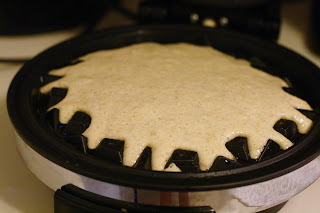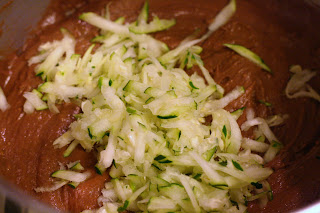There are few better smells in the world than freshly baked bread. I don't make it as often as I should, mostly because it is hard to fit in multiple risings on a weeknight or coordinate my weekend schedule around them. For a while there was a trend towards no-knead breads, and Jim Lahey's book My Bread
In addition to filling my kitchen with comforting aromas as it was baking, the unbaked dough releases the delicious scent of fermentation, one of my other favorite smells in the world, as it usually means fresh bread or beer. This bread is tender and moist on the inside with a wonderfully crusty outside, due in large part to preheating the Dutch oven for half an hour before putting the bread dough in the pot. You may end up with a few crumbs on your shirt, but each crunchy, chewy bite of this rustic bread is worth it.
Pane Integrale (Whole Wheat Bread)
from My Bread
2.25 c. (300 grams) bread flour
3/4 c. (100 grams) whole wheat flour
1.25 t. (8 grams) table salt
1/2 t. (2 grams) instant or other active dry yeast
1 1/3 c. (300 grams) cool (55 to 65 degrees F) water
Wheat bran, cornmeal, or additional flour for dusting
1. In a medium bowl, stir together the flours, salt, and yeast. Add the water and, using a wooden spoon or your hand, mix until you have wet, sticky dough, about 30 seconds. Cover the bowl and let sit at room temperature until the surface is dotted with bubbles and the dough is more than doubled in size, 12 to 18 hours.
2. When the first rise is complete, generously dust a work surface with flour. Use a bowl scraper or rubber spatula to scrape the dough out of the bowl in one piece. Using lightly floured hands or a bowl scraper or spatula, lift the edges of the dough in toward the center. Nudge and tuck in the edges of the dough to make it round.
3. Place a tea towel on your work surface and generously dust it with wheat bran, cornmeal, or flour. Gently place the dough on the towel, seam side down. If the dough is tacky, dust the top lightly with wheat bran, cornmeal, or flour. Fold the ends of the tea towel over the dough to cover it and place it in a warm, draft-free spot to rise for 1 to 2 hours. The dough is ready when it is almost doubled. If you gently poke it with your finger, it should hold the impression. If it springs back, let it rise for another 15 minutes.
4. Half an hour before the end of the second rise, preheat the oven to 475 degrees F, with a rack positioned in the lower third, and place a covered 4.5- to 5.5-quart heavy pot in the center of the rack.
5. Using pot holders, carefully remove the preheated pot from the oven and uncover it. Unfold the tea towel and quickly but gently invert the dough into the pot, seam side up. (Use caution-the pot will be very hot). Cover the pot and bake for 30 minutes.
6. Remove the lid and continue baking until the bread is a deep chestnut color but not burnt, 15 to 30 minutes more. Use a heatproof spatula or pot holders to carefully lift the bread out of the pot and place it on a rack to cool thoroughly.








































